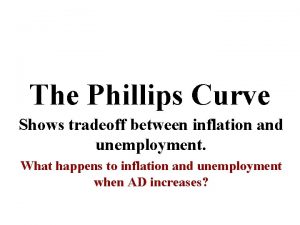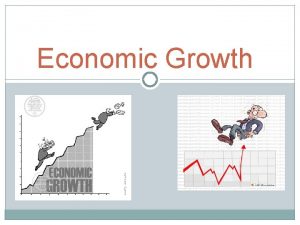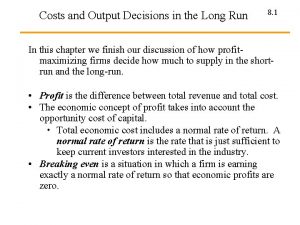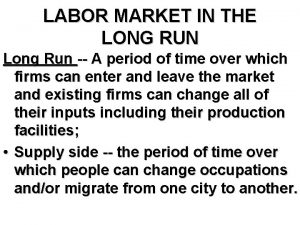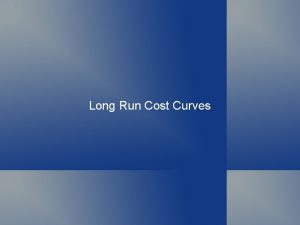STOCKS FOR THE LONG RUN Eastern Mediterranean University


























- Slides: 26

STOCKS FOR THE LONG RUN Eastern Mediterranean University Dr. Korhan Gokmenoglu Mohamad Kaakeh 137618 Masimba Mutuke 118198 Victoria Adedayo oni 128123 1

The impact of Economic growth on market valuation and the coming age wave 2

GDP growth and stock return 3

GDP growth and stock return 4

GDP growth and stock return • Real GDP growth is negatively correlated with stock market returns. • Why does this occur? • price is the present value of future dividends • Would economic growth positively impact future dividends and increase stock prices? • the determinants of stock prices are dividends and earnings on a per share basis, although economic growth influences aggregate earnings and dividends favorably, economic growth does not necessarily increase the growth of per share earnings or dividends. 5

GDP growth and stock return • Why? • Economic growth requires increased capital expenditures, this extra capital is financed by debt (loans, bonds, . . ) or equity (issuing new shares) and the added interest costs (debt) and the reduction of earnings (equity) reduce the growth of per share earnings. • growth can occur in the short term without capital expansion by using the existing plant more intensely. But the long run historical evidence strongly suggests that capital must be expanded to support higher growth. 6

The Gordon Dividend Growth Model • d is the next period dividend per share • r is the discount rate • g is the constant rate of future growth of dividends per share 7

Economic growth and stock returns 8

Factors that raise valuation ratios • Expected rate of returns on equities • The Equity-Risk premium 9

Factors that impact expected returns • the reduction in taxes on equity return due to the reduction in marginal and capital gains tax rates and inflation. • the reduction in transactions costs 10

The Equity-Risk premium • given the standard models of risk and return that economists had developed over the years, one could not explain the large gap between the returns on equities and fixed-income assets found in the historical data. • economic models predicted that either the rate of return on stocks should be lower, or the rate of return on fixedincome assets should be higher, or both. In fact, an equity premium as low as 1 percent or less could be justified. 11

More stable Economy • Attempts to justify the 3 to 3 1⁄2 percent risk premium found in the historical data o Some of these are based on very high aversion by individuals to lowering their consumption. o Others on those who dislike taking short-term losses on their investments even when they have substantial long-run gains. • Increasing stability of the real economy is the reason why premium might narrow in the future. 12

More stable Economy 13

New justified P-E Ratios • Average historical P/E ratio may no longer be appropriate • If inflation stays low, the tax policy remains favorable for equities, and the business cycle remains muted, one can justify price-to-earnings ratios in the low 20 s for the equity market. 14

The Age Wave • Inflation, tax policy, macroeconomic stability, and the drop in transactions costs are important factors influencing the valuation of equities. • Many are expecting a long and comfortable retirement by relying on government and private pension plans as well as tax supported medical services. • Unless we can exploit the change in demographic and economic changes then we may face a poorer future. • This forecast is not based on an unpredictable future but on events that have already transpired. 15

Demography is Destiny 16

The Bankruptcy of Government and Private Pension Systems • Although it is widely known that our Social Security and Medicare programs are threatened by these demographic trends, there are many who believe that they have accumulated sufficient private wealth to fund their retirement. 17

The Bankruptcy of Government and Private Pension Systems • But this may not be so. The same crisis that strikes the public pension programs can overwhelm private pensions as well. Since there will not be enough workers earning income, there will not be enough savings generated to purchase the assets the retirees must sell to finance their retirement. • Reasons why retirees cannot turn their savings into consumption • In a modern economy, wealth does not represent “stored consumption, ” 18

Reversal of a Century. Long Trend • Implication of less demand more supply • Social Security was passed in 1935, the average retirement age was 69. That age fell to 67 by 1950, and to 62 today. In 2003, for the first time, more Americans chose the reduced Social Security benefits at age 62 than the full benefit that starts at 65. Despite improving health, surveys indicate that the bulk of Americans and Europeans want to retire earlier, not late. 19

Reversal of a Century. Long Trend • But that will not be possible. Because of our aging population, it is most likely that future increases in the age of retirement will actually exceed the increase in the life expectancy and will cause—for the first time in history —an absolute reduction in the number of years in retirement. 20

The Global Solution: An Opportunity to Make a Trade • There is no easy solution. Nevertheless there is a solution that can help aging economies. This solution is call GLOBAL SOLUTION to the age wave • How effective is this solution will be? • Growth rate in the developing world • Degree to which world trade and capital market are kept open. 21

The figure below shows how crucial the growth rate of the developing world is to future retirees 22

Attraction of U. S. Capital • Why would the developing world wish to acquire our capital when their countries are expanding so rapidly? • that end, U. S. capital markets have many attractive attributes. Our country is still viewed as the fountainhead of innovation, discovery, invention, and entertainment, and our institutions of higher education are second to none. • For these capital movements to occur, we must be viewed as receptive to international capital. 23

CONCLUSION • faster economic growth in no way guarantees higher returns. • there are persuasive reasons why future valuation measures may be higher. Lower transactions costs, lower taxes, and increased economic stability. • the aging of the population is a critical issue impacting financial market returns. We cannot escape from our demographic realities. But we can take actions that will lead to a much brighter outcome. 24

Thank you for your attention Any questions? 25

questions • Why GDP growth and stock returns as shown in the historical data are negatively correlated? • Why the growth of earnings and dividends per share is higher since World War II than before even though the GDP growth is lower? 26
 Chapter 16 eastern mediterranean answers
Chapter 16 eastern mediterranean answers Short run equilibrium under perfect competition
Short run equilibrium under perfect competition Short run vs long run economics
Short run vs long run economics Perfect competition in short run and long run
Perfect competition in short run and long run Long and short
Long and short Once upon a time there lived a wise old teacher
Once upon a time there lived a wise old teacher Từ ngữ thể hiện lòng nhân hậu
Từ ngữ thể hiện lòng nhân hậu Latitude fatitude
Latitude fatitude Kwakiutl food
Kwakiutl food Run lola run themes
Run lola run themes Run lola run editing techniques
Run lola run editing techniques Multirule
Multirule Lola brigitta
Lola brigitta Nnlolas
Nnlolas Eku aviation
Eku aviation University of eastern colorado firewatch
University of eastern colorado firewatch Metu ocw
Metu ocw Shifters of srpc
Shifters of srpc Phillips curve graph
Phillips curve graph What is a short run supply curve
What is a short run supply curve Long run economic growth
Long run economic growth Long run market supply curve
Long run market supply curve Monopolistic competition in long run
Monopolistic competition in long run Long run economic growth
Long run economic growth Short run supply curve for a perfectly competitive firm
Short run supply curve for a perfectly competitive firm Long run aggregate supply curve
Long run aggregate supply curve The long-run aggregate supply curve shifts left if
The long-run aggregate supply curve shifts left if


















